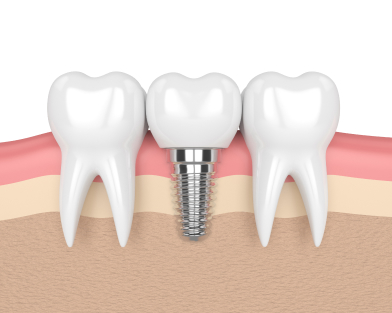
Dental implants are one of the most popular ways to replace missing teeth. It can be a little overwhelming when you hear all the different terms when looking for dental implants. A simple way to think about dental implants is that they are a solution to replace missing teeth or secure a full or partial denture.
Dental implants are typically made out of titanium. Titanium is a very biocompatible material used in knee replacements, surgical plates and screws and many other medical devices. After the dental implant is placed into the jaw bone, osseointegration is needed. Osseointegration is a direct connection of the bone to the dental implant. This allows the implant to be integrated into the bone and allows the implant to be strong enough to stay in the bone when used to hold a crown or retain a denture. This process is dependent on many factors and usually takes a few months to complete.
A major advantage and often overlooked aspect of dental implants are their ability to maintain jaw bone height and width. Unfortunately, bone loss happens rather quickly during the first year after the tooth is extracted and continues over time. When bone height and bone width are lost this can lead to the appearance of premature aging. Many people state after they had all their
teeth extracted that they looked 10-20 years older. After a few years, sometimes the bone loss is so great that there is not enough bone left to place a dental implant.
Another serious risk of extreme bone loss after a tooth extraction is the increased risk of a lower jaw fracture. Trauma to the chin or lower jaw from a fall or car accident can lead to an increased risk of lower jaw fracture due to the thin, weaker jaw bone. Dental implants help preserve the jaw bone height and width which gives the jaw more strength. If a tooth is extracted and an implant is not immediately placed but an implant would likely be used in the future, then bone grafting may be indicated. Bone grafting after a tooth extraction is simply placing bone in the space where the tooth used to be. An analogy would be that after a tree was removed from the ground and a large hole was present, the landscaper filled the hole with dirt so the ground would be level and not sunken where the tree used to be. The same is true with bone grafting. Its purpose is to preserve the jaw bone. Bone grafting also decreases postoperative pain, bleeding and the risks of a dry socket, which can be very painful.
Another big consideration when thinking about teeth replacement options is cost. Many people ask, ”how much does a dental implant cost in Oklahoma City?” There are literally hundreds of different types of dental implants. Dental implants vary in size and purpose. There are implants designed to replace missing teeth by the way of crowns, caps or dental bridges, and there are
implants designed to lock-in or snap-in loose dentures. With each of these types of implants, there are many different choices that can be utilized. Therefore, the correct response for dental implant cost would be, “the cost of a dental implant varies depending on which type is used.”
To determine which type of implant would be best for you, Dr. Rhodes or Dr. Windsor would need to take an X-ray to evaluate your bone quality and recommend the appropriate implant for your unique situation. In general, quality dental implants can range from $1,100-$1,700 for the implant and placement. Certain types of implants may require additional components to complete the treatment. Implants used for crowns, as an example, will require an abutment and crown a few months after the implant is placed. The abutment and crown are another procedure and fee that would be required in addition to the fee for the implant. There may also be parts or components that need to be placed inside the denture to snap or lock it onto the dental implants which would be an additional cost.
Dental implants are an excellent choice to replace missing teeth. Once they are integrated into the jaw bone they can last many years or even a lifetime. “I should have done this years ago” is a phrase we hear very often after we place dental implants. A dental implant will never get a cavity and dental implants are an excellent investment and long term solution to replacing missing teeth or stabilizing a loose denture. Advances in Dentistry places dental implants in Oklahoma City. Dr. Rhodes is a 1994 graduate of the University College of Dentistry and has placed dental implants for over 25 years.
All content property of Advances in Dentistry-all rights reserved.


